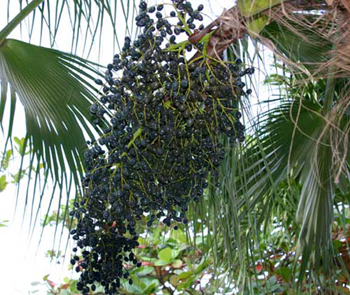Contents:
Common Names | Parts Usually Used | Plant(s) & Culture | Where Found | Medicinal Properties | Biochemical Information
Uses | How Sold | Warning | Resource Links
Scientific Names
 Acai Tree |
- Euterpe oleraceae
Common Names
- Acai berry
- Acai palm
- Cabbage palm
- Palm berry
Parts Usually Used
Berries
Back to Top
Description of Plant(s) and Culture

Acai Berries |
The acai plam tree grows to a height of up to 60 feet. The berries are about the size of blueberries and are dark purple. The taste is a cross between chocolate and red wine.
Back to Top
Where Found
Acai berries grow on the acai palm tree that grows in the Brazilian ranforests.
Back to Top
Medicinal Properties
In vitro and in vivo studies have shown that acai has antiinflammatory, antioxidant, and apoptotic effects.
Back to Top
Biochemical Information
- Acai Fruit
- Flavonoids: Anthocyanins (ACNs), Proanthocyanidins (PACs)
- Fatty acids: Oleic acid, Palmitic acid, Linoleic acid
- Acai Seed
- Procyanidins, Protocatechruic acid, Epicatechin
Uses
Acai has shown promising results in studies as an atioxidant, an anti-inflamatory and it seems to help prevent cancer. It also seems promising in tests as an MRI contrast agent.
Back to Top
How Sold
Juice, powder & capsules
Back to Top
Warning
Acai may interact harmfully with other cancer-fighting medications, and if you are on chemotherapy, it could interfere with the chemo medications. Consult your oncologist befoer taking acai.
Back to Top
Resource Links
LiveStrong.com: Acai Berry and Insomnia
LiveStrong.com: Acai Berry & Skin
LiveStrong.com: Acai Berry & Acne
eHow.com: Acai Berry Supplement Facts
LiveStrong.com: Herbs to Fade Discoloration
Medical News Today: Acai Facts
University of Florida News: Acai Berry
Memorial Sloan-Kettering Medical Center: Acai
PubMed.gov: Innovations in natural ingredients and their use in skin care.
